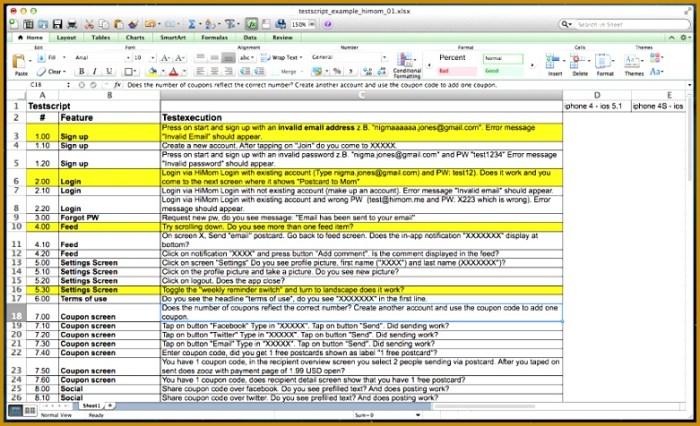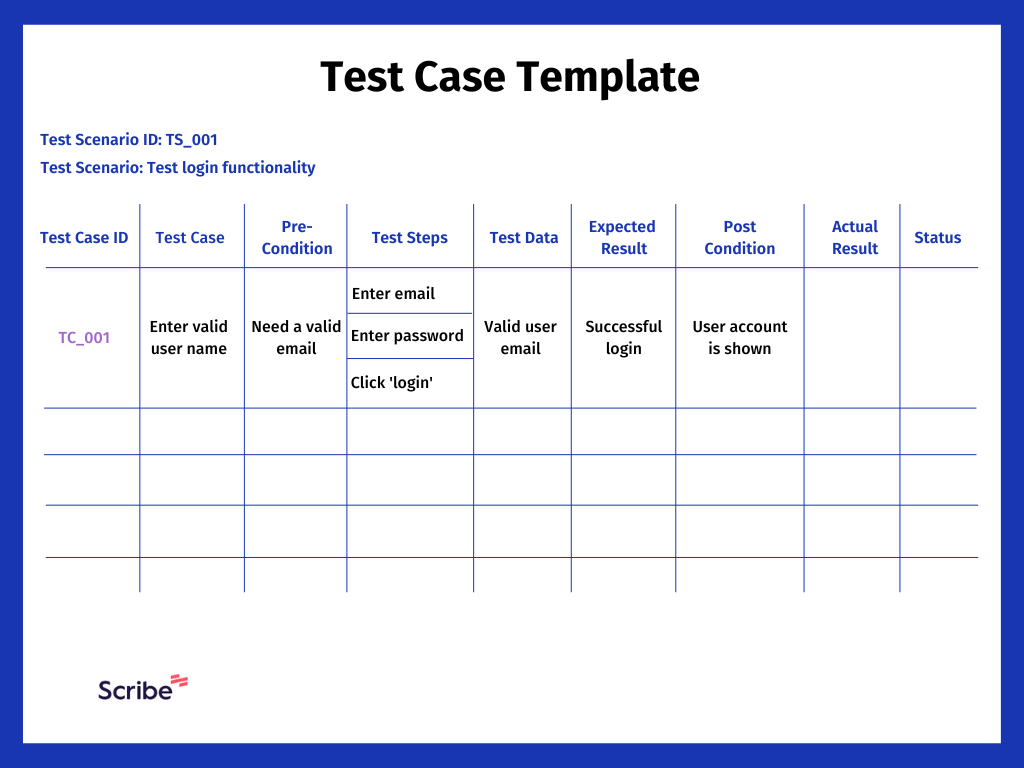In the ever-evolving landscape of quality assurance, Qa Document Templates have emerged as indispensable tools for streamlining processes, ensuring accuracy, and enhancing efficiency. These templates provide a structured framework for documenting quality-related information, fostering collaboration, and driving continuous improvement. In this comprehensive guide, we delve into the world of Qa Document Templates, exploring their definition, components, types, and best practices. We also provide practical examples and discuss the benefits of integrating these templates into quality management systems.
Qa Document Templates serve as standardized formats for capturing and organizing quality-related data. They play a pivotal role in ensuring consistency, reducing errors, and facilitating communication among stakeholders. By leveraging these templates, organizations can streamline their quality assurance processes, improve efficiency, and enhance overall quality.
Qa Document Template
A Qa Document Template is a structured guide that defines the requirements and procedures for creating and maintaining quality assurance (QA) documents. It provides a consistent framework to ensure that QA documents are comprehensive, accurate, and meet regulatory and industry standards.
Qa Document Templates are essential for organizations that need to demonstrate compliance with quality standards, such as ISO 9001 or FDA regulations. They help organizations to streamline the QA process, reduce errors, and improve the overall quality of their products and services.
Benefits of Using a Qa Document Template
Using a Qa Document Template offers several benefits, including:
- Ensures consistency and completeness of QA documents
- Reduces the risk of errors and omissions
- Facilitates compliance with regulatory and industry standards
- Improves the efficiency of the QA process
- Provides a centralized repository for QA documents
Components of a Qa Document Template

A Qa Document Template is a structured document that defines the requirements for creating and maintaining a quality assurance (QA) program. It includes essential components that provide a framework for developing and implementing QA processes.
The key components of a Qa Document Template include:
Purpose and Scope
Defines the purpose and scope of the QA program, including its objectives, responsibilities, and deliverables.
Quality Management System
Artikels the quality management system that will be used to implement the QA program, including its structure, processes, and procedures.
Quality Control Plan
Describes the specific quality control measures that will be implemented to ensure that products and services meet the required standards.
Quality Assurance Plan
Defines the quality assurance activities that will be performed to verify and validate the effectiveness of the QA program.
Quality Records
Lists the types of quality records that will be maintained and the procedures for managing them.
Quality Audits
Describes the procedures for conducting quality audits and the criteria that will be used to assess the effectiveness of the QA program.
Continuous Improvement
Artikels the process for continuous improvement of the QA program, including methods for identifying and addressing areas for improvement.
Types of Qa Document Templates
Intro paragraph
There are various types of Qa Document Templates available, each tailored to specific use cases and applications. Understanding the different types can help you choose the most appropriate template for your project.
Use Case: Software Development
Software Development Qa Document Templates provide a structured approach to testing and ensuring the quality of software products. These templates typically include sections for requirements gathering, test planning, test execution, and defect tracking.
Use Case: Manufacturing
Manufacturing Qa Document Templates focus on ensuring the quality of manufactured products. They may include sections for process control, inspection, and quality assurance audits. These templates help maintain product quality and compliance with industry standards.
Use Case: Healthcare
Healthcare Qa Document Templates prioritize patient safety and quality of care. They may include sections for clinical trials, patient safety reporting, and quality improvement initiatives. These templates help ensure that healthcare providers deliver safe and effective patient care.
Use Case: Service Industry
Service Industry Qa Document Templates focus on improving the quality of services provided. They may include sections for customer feedback, process improvement, and employee training. These templates help businesses enhance customer satisfaction and service delivery.
Creating a Qa Document Template
Creating a Qa Document Template is a piece of cake, innit? Here’s the lowdown on how to smash it:
- Plan the structure: Figure out what sections you need, like an intro, quality criteria, test cases, and so on.
- Organize the content: Make sure everything flows logically, with each section building on the last.
- Keep it concise: Don’t waffle on – get to the point and use clear, simple language.
- Use headings and subheadings: These help break up the text and make it easy to navigate.
- Proofread carefully: Check for any typos or errors before you finalize it.
Best Practices for Using Qa Document Templates
Best practices for using Qa Document Templates are crucial for maintaining accuracy and consistency. Following these guidelines can enhance the quality and effectiveness of your documentation.
It is essential to establish clear guidelines and procedures for template usage. Define the roles and responsibilities of individuals involved in creating, reviewing, and approving documents. This ensures a standardized approach and reduces the risk of errors.
Common Pitfalls to Avoid
Common pitfalls to avoid when using templates include:
- Inconsistent Use: Failing to adhere to established guidelines can lead to variations in document quality and accuracy.
- Lack of Review: Skipping or rushing the review process can result in undetected errors and inconsistencies.
- Incomplete or Outdated Templates: Using templates that are incomplete or outdated can compromise the accuracy and relevance of your documentation.
- Inadequate Training: Insufficient training on template usage can lead to incorrect or inconsistent document creation.
- Lack of Version Control: Failing to maintain proper version control can make it difficult to track changes and ensure document accuracy.
Benefits of Using Qa Document Templates
Using Qa Document Templates offers numerous advantages that can significantly enhance efficiency and quality within the QA process.
Enhanced Consistency and Standardization
Qa Document Templates ensure consistency in the format and structure of QA documents, eliminating variations that can lead to errors or misunderstandings. They provide a standardized framework that guides the creation of well-organized and easy-to-follow documents.
Examples of Qa Document Templates
Real-world examples of Qa Document Templates are prevalent in various industries. These templates provide a structured approach to ensure quality assurance and streamline processes.
One notable example is the Software Test Plan Template. It Artikels the scope, objectives, approach, and resources required for software testing. This template helps teams plan and execute comprehensive testing activities, ensuring the quality and reliability of software products.
Another example is the Inspection Checklist Template. It defines specific criteria and standards that products or services must meet. This template facilitates thorough inspections, identifying potential defects or areas for improvement. It ensures adherence to quality standards and enhances customer satisfaction.
Furthermore, the Quality Assurance Manual Template provides a comprehensive guide to an organization’s quality assurance system. It Artikels policies, procedures, and responsibilities related to quality management. This template helps organizations establish a robust quality framework, ensuring consistent and effective quality practices throughout their operations.
Integrating Qa Document Templates into Quality Management Systems

Yo, listen up! Integrating Qa Document Templates into your Quality Management System (QMS) is like the ultimate cheat code for quality control. These templates give you a sick framework to work with, so you can stay on top of compliance and smash your processes out of the park.
Benefits of Integration
Integrating Qa Document Templates into your QMS is like hitting the jackpot, fam. You’ll get:
– Compliance on Fleek: Say goodbye to those pesky compliance headaches. With templates, you’ll have all the documentation you need to prove you’re doing things by the book.
– Improved Processes: These templates are like a roadmap for your processes, guiding you every step of the way. You’ll eliminate guesswork and make sure everything’s running smoothly.
Questions and Answers
What is the purpose of a Qa Document Template?
A Qa Document Template provides a standardized format for documenting quality-related information, ensuring consistency, reducing errors, and facilitating communication among stakeholders.
What are the benefits of using Qa Document Templates?
Qa Document Templates enhance efficiency, improve quality, reduce errors, facilitate communication, and ensure compliance with quality standards.
What are the essential components of a Qa Document Template?
Essential components include a title, purpose statement, scope, responsibilities, procedures, and quality control measures.
How can I create an effective Qa Document Template?
Follow best practices such as defining the purpose, identifying stakeholders, organizing content logically, and ensuring clarity and conciseness.
